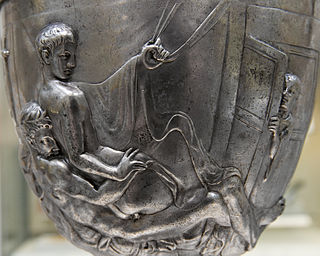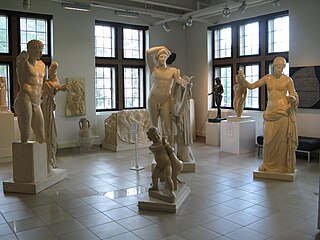Related Research Articles

The Greeks or Hellenes are an ethnic group and nation native to Greece, Cyprus, southern Albania, Anatolia, parts of Italy and Egypt, and to a lesser extent, other countries surrounding the Eastern Mediterranean and Black Sea. They also form a significant diaspora, with many Greek communities established around the world.

Classical antiquity, also known as the classical era, classical period, classical age, or simply antiquity, is the period of cultural history between the 8th century BC and the 5th century AD centered on the Mediterranean Sea, comprising the interlocking civilizations of ancient Greece and ancient Rome known as the Greco-Roman world. It is the period in which both Greek and Roman societies flourished and wielded huge influence throughout much of Europe, North Africa, and West Asia.
Societal attitudes towards same-sex relationships have varied over time and place. Attitudes to male homosexuality have varied from requiring males to engage in same-sex relationships to casual integration, through acceptance, to seeing the practice as a minor sin, repressing it through law enforcement and judicial mechanisms, and to proscribing it under penalty of death. In addition, it has varied as to whether any negative attitudes towards men who have sex with men have extended to all participants, as has been common in Abrahamic religions, or only to passive (penetrated) participants, as was common in Ancient Greece and Ancient Rome. Female homosexuality has historically been given less acknowledgment, explicit acceptance, and opposition. The widespread concept of homosexuality as a sexual orientation and sexual identity is a relatively recent development, with the word itself being coined in the 19th century.

Erotic art is a broad field of the visual arts that includes any artistic work intended to evoke erotic arousal. It usually depicts human nudity or sexual activity, and has included works in various visual mediums, including drawings, engravings, films, paintings, photographs, and sculptures. Some of the earliest known works of art include erotic themes, which have recurred with varying prominence in different societies throughout history. However, it has also been widely considered taboo, with either social norms or laws restricting its creation, distribution, and possession. This is particularly the case when it is deemed pornographic, immoral, or obscene.

The Story of Civilization (1935–1975), by husband and wife Will and Ariel Durant, is an 11-volume set of books covering both Eastern and Western civilizations for the general reader, with a particular emphasis on European (Western) history.

The History of Sexuality is a four-volume study of sexuality in the Western world by the French historian and philosopher Michel Foucault, in which the author examines the emergence of "sexuality" as a discursive object and separate sphere of life and argues that the notion that every individual has a sexuality is a relatively recent development in Western societies. The first volume, The Will to Knowledge, was first published in 1976; an English translation appeared in 1978. The Use of Pleasure, and The Care of the Self, were published in 1984. The fourth volume, Confessions of the Flesh, was published posthumously in 2018.

The history of Greece encompasses the history of the territory of the modern nation-state of Greece as well as that of the Greek people and the areas they inhabited and ruled historically. The scope of Greek habitation and rule has varied throughout the ages and as a result, the history of Greece is similarly elastic in what it includes. Generally, the history of Greece is divided into the following periods:

The Warren Cup is an ancient Greco-Roman silver drinking cup decorated in relief with two images of male same-sex acts. It was purchased by the British Museum for £1.8 million in 1999, the most expensive single purchase by the museum at that time. It is usually dated to the time of the Julio-Claudian dynasty.
The social construction of human sexuality and sexual behavior—along with its taboos, regulation, and social and political impact—has had a profound effect on the various cultures of the world since prehistoric times.

In classical antiquity, writers such as Herodotus, Plato, Xenophon, Athenaeus and many others explored aspects of homosexuality in Greek society. The most widespread and socially significant form of same-sex sexual relations in ancient Greece amongst elite circles was between adult men and pubescent or adolescent boys, known as pederasty. Certain city-states allowed it while others were ambiguous or prohibited it. Though sexual relationships between adult men did exist, it is possible at least one member of each of these relationships flouted social conventions by assuming a passive sexual role according to Kenneth Dover, though this has been questioned by recent scholars. It is unclear how such relations between same-sex partners were regarded in the general society, especially for women, but examples do exist as far back as the time of Sappho.
During the growth of the ancient civilizations, ancient technology was the result from advances in engineering in ancient times. These advances in the history of technology stimulated societies to adopt new ways of living and governance.
India has developed its discourse on sexuality differently based on its distinct regions with their own unique cultures. According to R.P. Bhatia, a New Delhi psychoanalyst and psychotherapist, middle-class India's "very strong repressive attitude" has made it impossible for many married couples to function well sexually, or even to function at all.
Greek love is a term originally used by classicists to describe the primarily homoerotic customs, practices, and attitudes of the ancient Greeks. It was frequently used as a euphemism for both homosexuality and pederasty. The phrase is a product of the enormous impact of the reception of classical Greek culture on historical attitudes toward sexuality, and its influence on art and various intellectual movements.
'Greece' as the historical memory of a treasured past was romanticised and idealised as a time and a culture when love between males was not only tolerated but actually encouraged, and expressed as the high ideal of same-sex camaraderie. ... If tolerance and approval of male homosexuality had happened once—and in a culture so much admired and imitated by the eighteenth and nineteenth centuries—might it not be possible to replicate in modernity the antique homeland of the non-heteronormative?

The history of nudity involves social attitudes to nakedness of the human body in different cultures in history. The use of clothing to cover the body is one of the changes that mark the end of the Neolithic, and the beginning of civilizations. Nudity has traditionally been the social norm for both men and women in hunter-gatherer cultures in warm climates, and it is still common among many indigenous peoples. The need to cover the body is associated with human migration out of the tropics into climates where clothes were needed as protection from sun, heat, and dust in the Middle East; or from cold and rain in Europe and Asia. The first use of animal skins and cloth may have been as adornment, along with body modification, body painting, and jewelry, invented first for other purposes, such as magic, decoration, cult, or prestige. The skills used in their making were later found to be practical as well.

The Western world, also known as the West, primarily refers to various nations and states in the regions of Australasia, Europe, and the Americas. The Western world likewise is called the Occident in contrast to the Eastern world known as the Orient. The West is considered an evolving concept; made up of cultural, political, and economic synergy among diverse groups of people, and not a rigid region with fixed borders and members. Definitions for "Western world" vary according to context and perspectives.

Western culture, also known as Western civilization, Occidental culture, or Western society, is an umbrella term which refers to the diverse heritage of social norms, ethical values, traditional customs, belief systems, political systems, artifacts and technologies of the Western world. The term may refer to the cultures of countries with historical ties to a European country, or number of European countries, and the variety of cultures within Europe itself. The earliest concept of Europe as a cultural sphere appeared during the Carolingian Renaissance of the 9th century, which reflected to the territories of the Western Christianity. However "European" as cultural term did not include the territories where the Orthodox Church or Islam represented the dominant religion until 19th century. Western culture originates from the mixing of Greco-Roman culture, Christian culture and Germanic culture.

The ancient Near East was the home of early civilizations within a region roughly corresponding to the modern Middle East: Mesopotamia, ancient Egypt, ancient Persia, Anatolia, and the Armenian highlands, the Levant, Cyprus, and the Arabian Peninsula. The ancient Near East is studied in the fields of Ancient Near East studies, Near Eastern archaeology, and ancient history.

Prostitution has been practiced throughout ancient and modern cultures. Prostitution has been described as "the world's oldest profession," although the oldest professions are most likely farmers, hunters, and shepherds.

The Museum of Antiquities is an archaeological museum at the University of Saskatchewan in Saskatoon, Canada. It opened in 1974 to provide an opportunity to study ancient works. The museum currently features a variety of Greek and Roman sculpture, and contains a collection of Near Eastern, Egyptian, Byzantine, Islamic and Medieval art. It is one of only a handful of museums of its kind in Canada.
In medieval Europe, attitudes toward homosexuality varied from region to region, determined by religious culture; the Catholic Church, which dominated the religious landscape, considered, and still considers, sodomy as a mortal sin and a "crime against nature". By the 11th century Sodomy was increasingly viewed as a serious moral crime and punishable by mutilation or death. Medieval records reflect this growing concern. The emergence of heretical groups, such as the Cathars and Waldensians, witnesses a rise in allegations of unnatural sexual conduct against such heretics as part of the war against heresy in Christendom. Accusations of Sodomy and unnatural acts were levelled against the Order of the Knights Templar in 1307 as part of Philip IV of France's attempt to suppress the order. These allegations have been dismissed by some scholars.